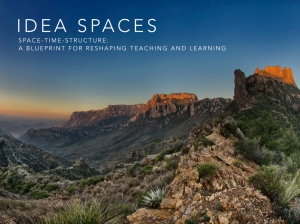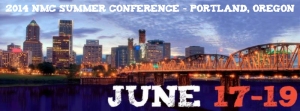Listening to Tom Haymes (director, technology & instructional computing at Houston Community College Northwest) talk about how to create idea spaces this afternoon at the New Media Consortium (NMC) 2014 Summer [ed-tech] Conference here in Portland, Oregon, I realized that worlds were converging. What better place, after all, to be hearing and dreaming about those creatively dynamic and innovative academic learning centers than at a conference which brings colleagues together to at least temporarily form an inspiring space for the development and sharing of ideas?
 The topic Haymes was addressing—the need to be “looking at our spaces, the time allotted for reflection, and the mental, institutional and cultural structures we put into place to support teaching and learning”—isn’t just something of interest to those of us at this first-rate ed-tech conference; it’s a topic that is essential to what I see my training-teaching-learning colleagues in workplace learning and performance (staff training) endeavors and in libraries, museums, and other community-based learning organizations considering, promoting, and doing.
The topic Haymes was addressing—the need to be “looking at our spaces, the time allotted for reflection, and the mental, institutional and cultural structures we put into place to support teaching and learning”—isn’t just something of interest to those of us at this first-rate ed-tech conference; it’s a topic that is essential to what I see my training-teaching-learning colleagues in workplace learning and performance (staff training) endeavors and in libraries, museums, and other community-based learning organizations considering, promoting, and doing.
While Haymes posed it in terms of academic settings by rhetorically asking why our classrooms often continue to look the way they have looked for generations, he could have just as easily been posing the same question to anyone involved in training-teaching-learning. Whether we are absorbing gems from the best of lecturers or suffering through deadly-dull lectures, we have access to a steady stream of research showing how relatively ineffective the lecture as a learning tool is, yet it continues to be the paradigm in much of what we encounter through our lifelong learning efforts.
Increasingly, however, we are also encountering wonderful extensions of the decades-long search for models more effective than the learner-as-sponge lecture model: the best of our connectivist massive open online courses (MOOCs), for example, create cross-platform virtual settings for engaging learning experiences; the information commons model that has extended beyond the walls of academic libraries into public library settings seems to be morphing into makerspaces and innovation centers that are changing the shape of some of our community learning centers, and those idea spaces that Haymes so tantalizingly dangled before us this afternoon give us something else to dream about—and strive to produce. It’s all part of moving us from what Haymes described as the quintessential learner question—“What do I have to do to get an A in this course?”—to the all-too-infrequently-asked question, “What can I learn in this class?”
And Haymes wasn’t quite done with us at that point; he also described how he and his campus colleagues are designing for synergistic innovation: “We really designed the entire campus to be a learning space, where all of the pieces work together”—which, again, is a wonderful goal for all of us in training-teaching-learning to explore and pursue since it places an emphasis on the same holistic approach to learning-space design as we should be taking to the learning process itself.
 We come full circle here: classrooms as idea spaces, and conferences as idea spaces where learning occurs naturally. We heard NMC CEO Larry Johnson begin the first full day of formal keynote addresses, presentations, and other activities with the playful directive “Let’s light this candle!” We heard him at the end of the day offer what I’ve come to accept as the “Conference Lament”–an acknowledgement that when you convene a creative group of trainer-teacher-lifelong learners who incorporate conference backchannels into their learning experience, you’re going to find that no conference wireless system can possibly keep up with all of us: “We’re an Internet organization; everywhere we go, we take it down,” he told conference participants in a moment of levity near the end of the day. “”We bought you a great Internet experience; I’m sorry you’re not getting it.” But what we did get as we reconvened as a group at the end of the day was a fabulous series of five-minute presentations from colleagues whose learning innovations make us wonder why we would settle for anything less than the most adventurous and productive approaches possible. And the icing on the cake was an end-of-day keynote presentation by photographer-visual storyteller Bill Frakes, whose short films on cranes and “a teacher remembered” were stunningly, heartbreakingly beautiful explorations of artistry, creativity, innovative use of technology, and the power of storytelling.
We come full circle here: classrooms as idea spaces, and conferences as idea spaces where learning occurs naturally. We heard NMC CEO Larry Johnson begin the first full day of formal keynote addresses, presentations, and other activities with the playful directive “Let’s light this candle!” We heard him at the end of the day offer what I’ve come to accept as the “Conference Lament”–an acknowledgement that when you convene a creative group of trainer-teacher-lifelong learners who incorporate conference backchannels into their learning experience, you’re going to find that no conference wireless system can possibly keep up with all of us: “We’re an Internet organization; everywhere we go, we take it down,” he told conference participants in a moment of levity near the end of the day. “”We bought you a great Internet experience; I’m sorry you’re not getting it.” But what we did get as we reconvened as a group at the end of the day was a fabulous series of five-minute presentations from colleagues whose learning innovations make us wonder why we would settle for anything less than the most adventurous and productive approaches possible. And the icing on the cake was an end-of-day keynote presentation by photographer-visual storyteller Bill Frakes, whose short films on cranes and “a teacher remembered” were stunningly, heartbreakingly beautiful explorations of artistry, creativity, innovative use of technology, and the power of storytelling.
There’s still another full day of sharing our temporary idea space here in Portland. And I have no doubt that when it comes to an end, the sense of augmented emotional reality that this sort of immersive environment creates will once again begin to dissipate. But the important and more long-term transformation that the idea spaces in our lives inspire are the learning model most worth pursuing—which is the gift our NMC colleagues are once again providing.

I am enjoying reading your posts from the NMC Conference! Your post this morning with comments about how our educational infrastructures look eerily similar to previous generations reminded me of this post I read earlier this week. I wanted to share it with you for a couple of reasons.
The Udacity.com website was brought to my attention by Diana Weaver, the director at Basehor Library. She is one of our up and coming newer MLS directors, and a former colleague at the NEKLS office. Diana was pointing out that Udacity is offering “nanodegrees” and credentials. Our keynote speaker at Innovation Day here in April was Garry Golden, who really hit on lifelong learning, the role of libraries as social learning centers, and these new forms of credentials – demonstrating that you have a particular skill or knowledge base. Diana said, “See – this is what Garry Golden was talking about. These mini-credentials and badges.”
As I poked around Udacity, I found their blog. This post in particular was of interest to me because the writer also addresses our archaic educational system, and how the world and learners are changing — but our structure has not. In some cases higher ed is not even ready to admit that its offerings no longer fit with the way people learn, work and live.
I wanted to pass it along to you, as I am still reflecting on what I read – and meshing it with what you are posting as well. Thanks for the excellent thoughts you are sending out!
http://blog.udacity.com/2014/06/announcing-nanodegrees-new-type-of.html